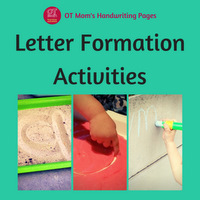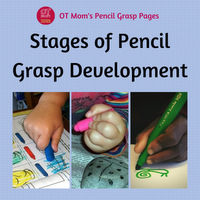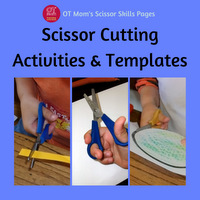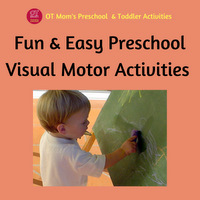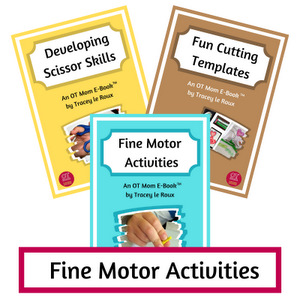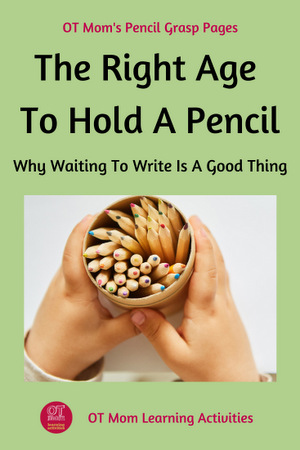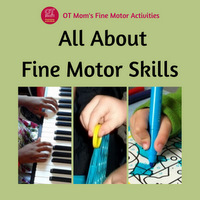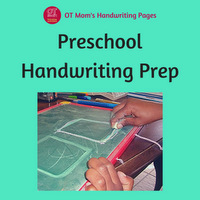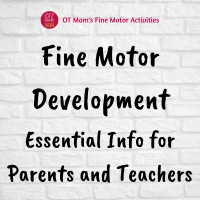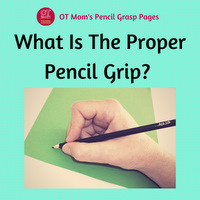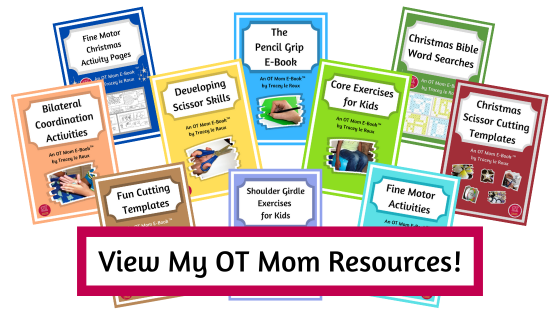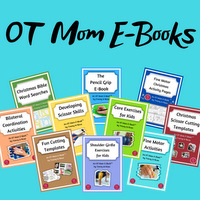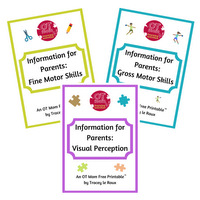- Home Page
- All About Pencil Grasp
- The right age to hold a pencil to write
The Right Age To Hold A Pencil
Why Waiting To Write Is A Good Thing
Parents of young kids often wonder when is the right age to hold a pencil. We feel the pressure to make sure our kids are developmentally on track, and questions about pencil grip, the right age for writing etc, are common!
I sometimes link to products (#Ad) that are similar to those I use and love. If you do purchase something through my links, I will receive a small commission that helps support my site - thank you!
The answer, however, may be surprising - earlier is not always better, especially when it comes to writing and pencil control!
Pushing a child to write before their hands are physically ready, can lead to frustration, messy handwriting, and even an incorrect pencil grip that is difficult to correct later.
In this Q&A page, I have tackled some of the common issues parents have raised over my years as an occupational therapist and homeschooling mom!
Key Takeaways For Busy Parents:
- Wait For Readiness: The ideal age for a child to hold and use a pencil for formal writing is around 5 years old. Before this, the joints, bones and muscles of their hands are actually not developed enough.
- Prioritize Play Over Pencils: The best way to prepare for writing is through play. Focus on hands-on activities that build hand strength and dexterity - find lots of free ideas on my site!
- Go Fat, Not Thin: Choose fat, chunky pencils and crayons, which are easier for small hands to grip and control.
- Focus on Fun, Not Form: Expose your preschooler to creative, experimental fun. Scribbling and drawing should be only a part of a wide range of hands-on activities.
On This Page:
- What Is The Right Age To Learn To Hold A Pencil To Write?
- What Can I Do To Prepare My Child For Writing?
- My Child Is Smart And Knows Their Letters and Numbers But Struggles To Write And Draw - What Can I Do To Help?
- What Are The Best Pencils For Preschoolers?
- What Not To Do - Common Mistakes To Avoid
- Are You Concerned About Your Child?

What Is The Right Age To Learn To Hold A Pencil To Write?
This is an excellent question that Vasanti from India asked me! Although children naturally try to copy adults and scribble from an early age, most early childhood experts agree that formal writing instruction with a pencil should not begin before age 5.
Before the age of 5, the muscles and bones in your child's hands are still developing. If your child is forced to hold a pencil to write before the hands are ready, they could likely experience discomfort, fatigue and frustration.
It is more important for your child to develop hand strength and dexterity through a variety of playful fine motor activities.
If you feel academic pressure from your child's preschool to help your child master the ABC's, rather practice writing skills WITHOUT using a pencil - I have loads of fun ideas to help kids master letter formations and writing words that don't use a pencil: check them out here:
If you give your child time to become developmentally ready to master pencil control, they are more likely to be successful, and have a positive attitude to handwriting when formal schooling starts!
If you are unsure of what your child's pencil grip should look like, here is a brief overview of the developmental stages of holding a pencil.
What Can I Do To Prepare My Child For Writing?
If your child is too young start writing, but you want to help prepare your child in advance, you have come to the write right place!
To build a strong foundation for writing, children should be engaging in a wide variety of fine motor activities to strengthen their hands and improve finger skills.
Here are some of my suggestions for hands-on fine motor activities parents can do with their kids at home:
- fine motor playdough activities
- lots and lots of scissor cutting activities
- hand strengthening activities
- finger control activities
- For toddlers, check out these simple hands-on toddler fine motor activities that you can incorporate into your daily routine.
It is also important to develop the visual motor skills needed to form the letters.
- Try these simple visual motor activities for toddlers, which include stacking blocks and pouring activities
- Preschoolers can be encouraged to trace simple shapes and patterns on large surfaces, such as in sand, on a blackboard or on an easel.
These activities will help prepare your child for handwriting.
My Child Is Smart And Knows Their Letters and Numbers But Struggles To Write And Draw - What Can I Do To Help?
If you've ever thought "my 4 year old knows his letters but can't write them", you are not alone! It is a common developmental stage.
Many kids have picked up letters and numbers and basic reading skills through educational programs, digital games and apps, but have not yet mastered actually forming the letters and writing with a pencil on paper.This is not a reflection of their intelligence, but rather that their fine motor and visual motor skills need some more practice.
My recommendation to parents of preschoolers is to separate the skills.
It is helpful to think of "learning to write" as two separate skills:
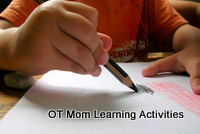 Developing pencil control
Developing pencil control- The ability to hold a pencil and control it
This requires hand strength and finger dexterity. Your child also needs good core and shoulder girdle stability as a foundation for fine motor skills.
So encourage lots of indoor and outdoor gross motor play, and check out my simple core exercises and shoulder exercises for activities you can do at home! - Letter formation
This requires visual-motor integration and copying skills. Remove the stress of practicing on a worksheet - rather use multi-sensory letter formation activities that don't require perfect pencil control. If you need some guidance on how to help your child master writing letters, read my tips for letter formations to help you.
What Are The Best Pencils For Preschoolers?
For toddlers and preschoolers, thicker tools are easier for small, developing hands to grip.
Using a thin pencil or crayon before their hands are ready, can be very tiring, as they are focusing all their energy on just holding the tool, instead of on being creative.
- I recommend fat pencils for preschoolers, and you can also get fat markers and chunky crayons. Even older kids with poor fine motor skills can benefit from using fatter pencils.
- Brands like Ticonderoga's oversized beginner pencils#Ad are ideal for young children who want to scribble and draw.
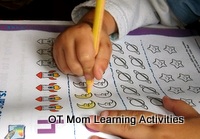 Using a jumbo pencil crayon
Using a jumbo pencil crayonWhat Not To Do - Common Mistakes To Avoid
- Don't force the use of thin, adult-sized pencils too early. Keep tools chunky!
- Avoid excessive use of worksheets and pencil-and-paper drills - rather practice letter formations and writing names on a large surface like a board or in a sand tray.
- Don't feel pressured to compare your child's progress to others, particularly to those being flaunted on social media. Every child is unique and has their own strengths and their own areas that need support.
- Work on getting a good balance between time on devices and hands-on play. All of the fine motor and handwriting apps in the world, don't compare to hands-on play with playdough, blocks and finger-painting!
Are You Concerned About Your Child?
- If you are at all concerned about your child's ability to hold a
pencil, or if they are behind their peers in learning to write, please
do reach out to an occupational therapist (OT). An OT can carry out a
full evaluation which pinpoints the exact areas in which your child
needs support, and can help you create a targeted plan to boost those
skills.
- Also consider a vision test. If your child specifically struggles to write within the lines, it is worth getting their eyes checked by a developmental optometrist to rule out any delays in functional visual skills.
-
If you are looking for simple fine motor activities to do at home to develop your child's skills, then check out my fine motor resources!
These have been created to support parents who are on a tight budget, and are filled with hands-on photographed activities that you can start doing with your child today!
In Conclusion
Your child's readiness for writing is more important than their age!
Remember, the goal is not to have the earliest writer in the class, but to have a child who loves learning, writing and creating.
By focusing on playful, hands-on activities you are giving your child the foundational tools and the confidence they need for handwriting when the time is right! You are not just building hand strength, you are building a confident, happy learner!
Well done on being a proactive parent!
Sign up for my free, occasional newsletter to stay in touch with new pages and activities on my site!
- Home Page
- All About Pencil Grasp
- The right age to hold a pencil to write
Share this page to help others!
Related Pages
Didn't find what you were looking for? Try a search of my site!
